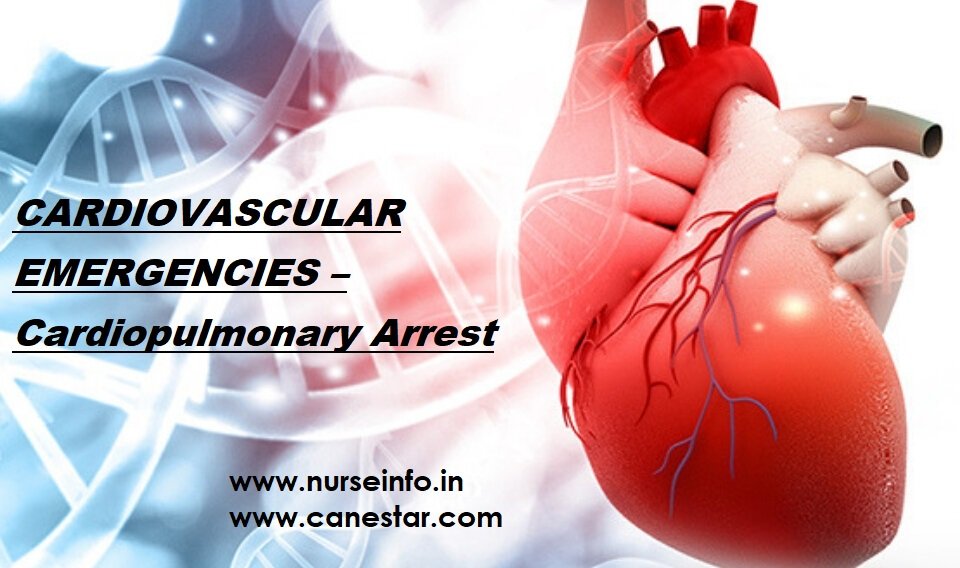CARDIOVASCULAR EMERGENCIES – Cardiopulmonary Arrest (Types, Diagnosis and Treatment)
Cardiovascular emergencies are life-threatening disorders that must be diagnosed quickly to avoid delay in treatment and to minimize morbidity and mortality.
Cardiac emergencies includes
- Cardiopulmonary arrest
- Hypertensive emergency
- Aortic aneurysm (ruptured)
- Aortic dissection
- Air embolism (arterial)
- Cardiac tamponade
- Cardiac arrhythmia
- Ventricular fibrillation
- Myocardial infarction (heart attack)
CARDIOPULMONARY ARREST
Cardiac arrest, also known as cardiopulmonary arrest or circulatory arrest, is the cessation of functional circulation of the blood due to failure of the heart to contract effectively.
A cardiac arrest is different from (but may be caused by) a heart attack, where blood flow to the muscle of the heart is impaired. It is different from congestive heart failure, where circulation is substandard, but the heart is still pumping sufficient blood to sustain life.
Cardiac arrest is a medical emergency that, in certain situations, is potentially reversible if treated early. Unexpected cardiac arrest can lead to death within minutes: this is called sudden cardiac arrest (SCD).
CLASSIFICATION OF CARDIOPULMONARY ARREST
Cardiac arrest is classified into two types:
- Shockable
- Nonshockable
SHOCKABLE
- In this type the rhythm is present but abnormal
- The two “shockable” rhythm are ventricular fibrillation and pulseless ventricular tachycardia
- Ventricular fibrillation: It is a condition in which there is uncoordinated contraction of the cardiac muscle of the ventricles in the heart, making them quiver rather than contract properly.
- Ventricular fibrillation is a medical emergency that requires prompt Advanced Life Support Interventions. If this arrhythmia continues for more than a few seconds, it will likely degenerate further into asystole (‘flatline’). This condition results in cardiogenic shock and cessation of effective blood circulation. As a consequence, sudden cardiac death (SCD) will result in a matter of minutes. If the patient is not revived after a sufficient period (within roughly 5 minutes at room temperature), the patient could sustain irreversible brain damage and possibly become brain dead due to the effects of cerebral hypoxia. On the other hand, death often occurs if sinus rhythm is not restored within 90 seconds of the onset of VF, especially if it has degenerated further into asystole.
- Ventricular tachycardia: it is a type of tachycardia, or a rapid heartbeat that starts in the bottom chambers of the heart called ventricles. The ventricles are the main pumping chambers of the heart. This is a potentially life-threatening arrhythmia because it may lead to ventricular fibrillation, asystole, and sudden death.
NONSHOCKABLE
- When a patient’s ECG shows flatlines it is called an asystole. It is not a shockable rhythm because there is no signal left to reset. This means the electrical impulse is gone and cannot be recovered.
- ‘Nonshockable’ rhythms are asystole and pulseless electrical activity
- Asystole: a life threatening cardiac condition characterized by the absence of electrical and mechanical activity in the heart. Clinical signs include apnea and lack of pulse. Without cardiac monitoring, asystole cannot be distinguished from ventricular fibrillation
- Pulseless electrical activity or PEA refers to a cardiac arrest situation in which a heart rhythm is observed on the electrocardiogram that should be producing a pulse, but is not.
DIAGNOSIS AND TREATMENT
The American Heart Association, in collaboration with the International Liaison Committee on Resuscitation, has established guidelines for resuscitation of cardiac arrest patients. In each resuscitation scenario, four concepts should always apply:
- Activate EMS or the designated code team
- Perform basic life support (CPR)
- Evaluate heart rhythm and perform early defibrillation as indicated
- Deliver advanced life support (e.g. intubation, intravenous (IV) access, and transfer to a medical center or intensive care unit).

CARDIOVASCULAR EMERGENCIES – Cardiopulmonary Arrest (Types, Diagnosis and Treatment)

